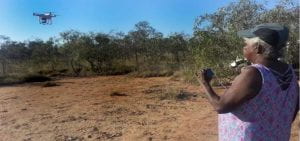Digital Literature Review: Dunggula

Dunggula is a digital touch book based on an Aboriginal creation story about the Murray River. It is a story that has been shared orally and passed down through the generations. This interpretation was a combined effort of primary students and the Sharing Stories Foundation. Dunggula is a curious mix of images. The children’s drawings are rudimentary but capture the essence of the story perfectly. They are then animated and move across the screen. Interspersed between this are aerial images of the land. The story is simplistic in nature but in listening to it in the language of its creation gives it true power to engage the listener and reader.
The story is spoken in part in the Aboriginal language of Bangerang and partly in English. Spoken by Roland Atkinson a member of the Bangerang community (Australian Government, 2019). His uncle Sandy Atkinson was considered the custodian of the story before his passing. Keeping this ancient and vanishing language alive is of vital importance to Atkinson and that emotion is in evidence in the recording of it for Dunggula. The creating of the story has now brought a new motivation to the community with a 700-word dictionary of Bangerang language being produced. Future generations will be able to learn this historic language thanks to Dunggula.
Dunggula uses student-created artworks, animations, sound designs and drone footage in its version. It tells the story of the creation of the Murray River and the journey of Gunyuk, a wise old Bangerang woman who meets with the god Baiami, to request water for her people. Baiami, sends the rainbow serpent to make a riverbed before delivering rain that fills the Dunggula (the Murray River).
Sharing Stories, the foundation behind Dunggula, works with multiple Aboriginal communities to help children and elders record ancient creation stories in various digital formats for use in their communities (Sharing Stories, 2020). With permission from the elders, some of those stories are then utilised for educational purposes. The books they produce, combine old and new effortlessly to create something that will help preserve the rich Aboriginal history for generations to come.
The making of Dunggula saw a lovely melding of cultures in which 12 Indigenous children chose 12 non-indigenous children to partner with. The children were then taken to key sites around the Murray River and immersed in the story by elders from the community (Bock, 2020). The students used a combination of old and new including drawing and painting, Photoshop and Garage Band to produce an imaginative multidimensional story.
While rudimentary, the artworks in Dunggula appear tactile and give the impression of paper rather than of a digital media. While current research suggests that there is little difference in comprehension between paper and screens, consumer reports do state that modern devices fail to recreate the tangible experience people enjoy (Jabr, 2013). Dunggula’s textured appearance goes a long way to connect with this experience.
Dunggula has a wealth of application potential for every classroom. The Victorian curriculum English strand for year 7 includes the descriptor VCELA370 (VCAA, 2020). This content descriptor requires the students to learn to analyse how point of view is generated in visual texts, comparing choices for point of view in animations and experimenting with digital storytelling. Tasks could be built around the students listening to and reading Dunggula. Before moving on to create a digital story themselves.
There are also a number of cross-curriculum priorities that can be met utilising Dunggula. In levels 7 and 8 alone, the book when built into a unit of work could assist in helping the students achieve outcomes in Media Arts, Visual Arts, and Civics and Citizenship (VCAA, 2020c). In Visual Arts at level 7 and 8, students could explore the techniques, technologies and processes used throughout Dunggula to meet the content descriptor VCAVAE034.
A digital touch book such as Dunggula definitely closes the gap between what is a book and what is an audio-visual resource. As defined by Lamb (2011) a book is a published collection of related pages or screens. Dunggula meets that criteria but how close to the line can other books go. Readers today want books that entertain them, that allow them to be immersed in the material in a similar way they are immersed in online gaming (Larson, 2009). Dunggula does this in a highly simplistic manner. With its childlike imagery and ideas, this books is produced by children, aimed at children and will help them all to context with the topic.
References
Australian Government. (2019). IY2019: Primary students bring Murray River story to life. Department of Infrastructure, Transport, Regional Development and Communications. https://www.arts.gov.au/departmental-news/iy2019-primary-students-bring-murray-river-story-life
Bock, A. (2020). Children and elders go digital to tell ancient Indigenous stories. https://www.smh.com.au/national/children-and-elders-go-digital-to-tell-ancient-indigenous-stories-20200120-p53t0g.html
Jabr, F. (2013). The Reading Brain in the Digital Age: The Science of Paper versus Screens. https://www.scientificamerican.com/article/reading-paper-screens/
Lamb, A. (2011). Reading redefined for a transmedia universe. Learning and Leading with Technology, 39(3), 12-17. Retrieved from http://ezproxy.csu.edu.au/login?url=http://search.ebscohost.com/login.aspx?direct=true&db=ehh&AN=67371172&site=ehost-live
Larson, L.C. (2009). Digital literacies. Journal of Adolescent and Adult Literacy, 53(3), 255-258. http://newcenturynewreaders.pbworks.com/f/Digital+Literacies.pdf
Sharing Stories Foundation. (2020). About us. In Sharing Stories Foundation website. https://sharingstoriesfoundation.org/about-us/
Victorian Curriculum and Assessment Authority. (2020). Victorian Curriculum: Foundation-10; English: Level 10. https://victoriancurriculum.vcaa.vic.edu.au/level10
Victorian Curriculum and Assessment Authority. (2020c). Victorian Curriculum: Foundation-10; Cross-curriculum priorities. https://victoriancurriculum.vcaa.vic.edu.au/static/docs/Learning%20about%20Aboriginal%20and%20Torres%20Strait%20Islander%20histories%20and%20cultures.pdf
